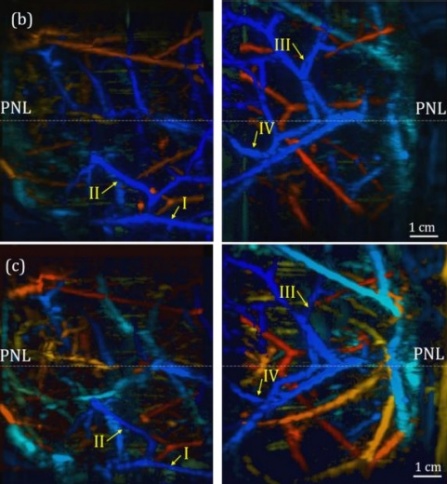New Portable Photoacoustic Breast Imaging System For Breast Cancer Developed By University Of Buffalo
Researchers from the
University Of Buffalo have developed a new,
portable breast imaging system that has the potential to better identify
breast cancer in women with
dense breast tissue. That is among the findings of a study published in the journal
IEEE Transactions on Biomedical Engineering .
The research study was led by
University at Buffalo researchers in collaboration with Roswell Park Comprehensive
Cancer Center and Windsong Radiology.
 The images above show 3D vasculature of breast tissue acquired by the Dual
The images above show 3D vasculature of breast tissue acquired by the Dual
Scan Mammoscope. The vessels in blue are closest to the breast surface, while
the ones in red are located deeper in the tissue. Credit: Jun Xia, University at Buffalo.
Dr Jun Xia, a researcher from
University Of Buffalo and the study's lead author told
Thailand Medical News, "We're developing a new imaging system, it's called a
Dual Scan Mammoscope that combines light and ultrasound technology. We believe it has the potential to help detect
breast cancer earlier, thereby increasing survival rates.”
Dr Jun Xia, Ph.D., is an assistant professor in the Department of Biomedical Engineering, a joint program of the School of Engineering and Applied Sciences and the Jacobs School of Medicine and Biomedical Sciences at UB.
Conventional mammograms are the best tests doctors have to find
breast cancer early, according to the Centers for Disease Control and Prevention. However, they are less effective for women with
dense breast tissue. There are alternatives methods in such cases, including MRI. But MRI tests are costly, they require intravenous contrast agents that can cause allergic reactions, and they're not easily portable.
The new
Dual Scan Mammoscope, or
DSM, is similar to a mammogram, in that patients stand upright to have their breast compressed for imaging. Unlike mammograms, however, the DSM requires only mild compression of the breast, likely reducing the severity of pain that women can experience pain during the procedure.
However, unlike a mammogram, the
DSM is a radiation free-test. It uses a laser to illuminate breast tissue. In turn, this generates acoustic waves that are measured by ultrasound technology. The combination of lasers and ultrasound is an imaging technique called photoacoustic tomography.
Whereas MRI requires a contrast agent, the
DSM test uses hemoglobin, a protein in red blood cells that carries oxygen throughout the body. The technology Xia and his colleagues are developing features two simultaneous scans, one working from the bottom of the breast while the other works from the top.
The platform design, Dr Xia says, ensures optimal light delivery and acoustic
detection, enabling imaging deep into
breast tissue. It's also portable; for example, it could easily fit into mobile mammogram units.
In research laboratory tests, the research team imaged breast sizes B, D and DD. The study highlights the D breast test, which shows imaging through 7 centimeters, the first time a
photoacoustic system produced imaging that deep, the research team believes.
Dr Xia says the
DSM method shows promise in detecting
tumors in the sub-millimeter range, provided they exhibit sufficiently developed blood vessels.
The research team from the
University of Buffalo plans additional studies, including the imaging of more patients with different breast sizes and tumor characteristics, to ensure the
DSM machine's effectiveness.
Reference : Nikhila Nyayapathi et al. Dual Scan Mammoscope (DSM) - A New Portable Photoacoustic Breast Imaging System with Scanning in Craniocaudal Plane, IEEE Transactions on Biomedical Engineering (2019). DOI: 10.1109/TBME.2019.2936088
